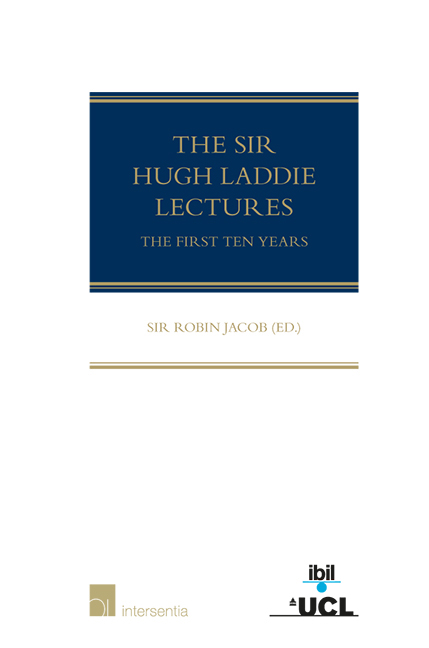Book contents
- Frontmatter
- Preface
- Contents
- List of Contributors
- The Insatiable Appetite for Intellectual Property Rights
- The Function of a Trade Mark: Hugh Laddie and the European Court of Justice
- From National Patent Litigation to a European Patent Court: A Dream, A Wish, or Soon, Reality?
- Killing the Goose that Laid the Golden Egg: Too Many Trade Marks? Use and Intention to Use in EU Trade Mark Law
- The Growing Imperative to Internationalise the Law
- Community Trade Marks: A Swiss Cheese?
- The Culture of the Public Domain: A Good Thing?
- IP and Advocacy
- Patents and Populism
- Towards a Global Copyright Law?
- Apologia Pro Vita Sua: A HiFi Retrospective and a Modest Prospective
- About the Editor
The Insatiable Appetite for Intellectual Property Rights
Published online by Cambridge University Press: 09 November 2019
- Frontmatter
- Preface
- Contents
- List of Contributors
- The Insatiable Appetite for Intellectual Property Rights
- The Function of a Trade Mark: Hugh Laddie and the European Court of Justice
- From National Patent Litigation to a European Patent Court: A Dream, A Wish, or Soon, Reality?
- Killing the Goose that Laid the Golden Egg: Too Many Trade Marks? Use and Intention to Use in EU Trade Mark Law
- The Growing Imperative to Internationalise the Law
- Community Trade Marks: A Swiss Cheese?
- The Culture of the Public Domain: A Good Thing?
- IP and Advocacy
- Patents and Populism
- Towards a Global Copyright Law?
- Apologia Pro Vita Sua: A HiFi Retrospective and a Modest Prospective
- About the Editor
Summary
THE PLACE OF IP RIGHTS WITHIN THE WESTERN ECONOMIC MODEL
Some years ago, a major British newspaper published a cartoon by Patrick Blower. It must have been near Christmas. It depicted the infant Jesus in Mary's arms in the manger and the three Magi bearing gift s. However, a lawyer had squeezed in front of the Magi and is showing Mary a draft contract. At the bottom of the cartoon are the lawyer's words, ‘I’ d like to patent his face, it could be worth millions in merchandising’. The terminology may not be entirely accurate, but the sentiment is pure 21st century. There can be few who have not heard of sports stars such as Tiger Woods, David Beckham, or Roger Federer, or missed the media comment on the huge amounts they can expect to earn from exploiting their intellectual property (hereafter ‘IP’) rights. The discussion of IP rights in news channels is not limited to merchandising rights like these. There is frequent reference to new patented medicines and techniques, to the eternal battle against counterfeiters of medicines, films, designer goods, and soft ware, and to the disputes between services like Google and YouTube and those that claim that their online services include unlicensed copies which infringe third-party copyrights. IP rights are all around us and their spread and importance has meant that awareness of them is no longer restricted to a small band of lawyers and owners.
‘IP rights’ is the collective name given to a disparate group of property rights, largely created by statute, which protect the creations of the human mind. They include patents, which create monopolies to protect inventive new products and processes, and copyright, which covers a diverse group of generally artistic creations such as literature, music, drawings and paintings and, now, films, soft ware, records, and broadcasts. Then there are various types of design right, which, by and large, protect the appearance of articles, database rights, which, as their name suggests, protect databases, and trade marks, which were created to protect the trading names and livery under which goods and services are marketed. All of these are exclusive rights. That is to say, they give the owner the power to stop all others from using the invention, or copying the musical work, or trading under the trade mark or one similar to it.
- Type
- Chapter
- Information
- The Sir Hugh Laddie LecturesThe First Ten Years, pp. 1 - 18Publisher: IntersentiaPrint publication year: 2019



